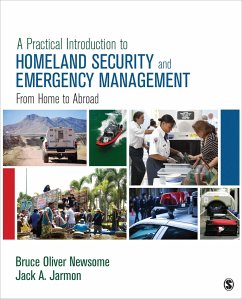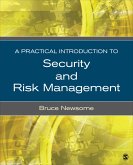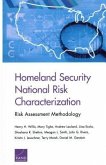Bruce Oliver Newsome, Jack A Jarmon
A Practical Introduction to Homeland Security and Emergency Management
From Home to Abroad
Bruce Oliver Newsome, Jack A Jarmon
A Practical Introduction to Homeland Security and Emergency Management
From Home to Abroad
- Broschiertes Buch
Andere Kunden interessierten sich auch für
![A Practical Introduction to Security and Risk Management A Practical Introduction to Security and Risk Management]() Bruce Oliver NewsomeA Practical Introduction to Security and Risk Management162,99 €
Bruce Oliver NewsomeA Practical Introduction to Security and Risk Management162,99 €![Terrorism and Homeland Security Terrorism and Homeland Security]() Gus MartinTerrorism and Homeland Security190,99 €
Gus MartinTerrorism and Homeland Security190,99 €![Homeland Security Intelligence Homeland Security Intelligence]() James E SteinerHomeland Security Intelligence148,99 €
James E SteinerHomeland Security Intelligence148,99 €![See Something, Say Nothing: A Homeland Security Officer Exposes the Government's Submission to Jihad See Something, Say Nothing: A Homeland Security Officer Exposes the Government's Submission to Jihad]() Philip HaneySee Something, Say Nothing: A Homeland Security Officer Exposes the Government's Submission to Jihad17,99 €
Philip HaneySee Something, Say Nothing: A Homeland Security Officer Exposes the Government's Submission to Jihad17,99 €![Homeland Security and Criminal Justice Homeland Security and Criminal Justice]() Homeland Security and Criminal Justice63,99 €
Homeland Security and Criminal Justice63,99 €![An Introduction to Civil Wars An Introduction to Civil Wars]() Karl R DerouenAn Introduction to Civil Wars107,99 €
Karl R DerouenAn Introduction to Civil Wars107,99 €![Homeland Security National Risk Characterization Homeland Security National Risk Characterization]() Henry H WillisHomeland Security National Risk Characterization23,99 €
Henry H WillisHomeland Security National Risk Characterization23,99 €-
-
-
Produktdetails
- Verlag: Sage Publications
- Seitenzahl: 632
- Erscheinungstermin: 27. Oktober 2015
- Englisch
- Abmessung: 229mm x 188mm x 23mm
- Gewicht: 921g
- ISBN-13: 9781483316741
- ISBN-10: 1483316742
- Artikelnr.: 42699081
Hinweis: Dieser Artikel kann nur an eine deutsche Lieferadresse ausgeliefert werden.
- Herstellerkennzeichnung
- Libri GmbH
- Europaallee 1
- 36244 Bad Hersfeld
- gpsr@libri.de
Bruce Oliver Newsome, PhD, is a lecturer in the School of International & Area Studies at the University of California, Berkeley. Before teaching, he was a research policy scientist at the RAND Corporation in Santa Monica, California. He earned his undergraduate degree with honors in war studies from Kings College London, a master's degree in political science from the University of Pennsylvania, and PhD in international studies from the University of Reading.
Part I. Scope
Chapter 1. Homeland Security Definitions and Structure
Learning Objectives and Outcomes
What Is Security?
Security Domains
Homeland Security
Final Case Study: Should the DHS Be Abolished? (Michael D. Tanner and
Christian Beckner)
Chapter Summary
Key Terms
Questions and Exercises
Chapter 2. Policy and Law in Homeland Security
Learning Objectives and Outcomes
Assessing Homeland Security Risk
The Just War
Homeland Security Policy
Homeland Security in Law and Policy
Summary
Final Case Study: How Has Homeland Security Policy and Law Changed Since
9/11? (Tom Kean)
Chapter Summary
Key Terms
Questions and Exercises
Part II. Hazards and Threats
Chapter 3. Terrorism
Learning Objectives and Outcomes
Definitions
Actors
Behavior and Activities
Targets
Motivation, Ideology, and Intent
Terrorism Frequency and Distribution
The Outcomes and the Cost of Terrorism
Terrorist Targets
Terrorist Profiles
American Terrorists
Counterterrorism
U.S. Counterterrorism Since 9/11
Final Case Study: How Should We Assess the Terrorist Threat in Formulating
Policy? (Bob Kerrey)
Chapter Summary
Key Terms
Questions and Exercises
Chapter 4. Transnational Crime
Learning Objectives and Outcomes
Definition of Transnational Crime
The Structure of Transnational Crime Organizations
How Motives of Transnational Crime Organizations Differ From Terrorists
Similarities Between Transnational Crime Organizations and International
Terrorism With Respect to Modi Operandi
How Transnational Crime Exploits the Mechanisms of Globalization and
Technology in Similar Ways as Legitimate Actors
Transnational Crime Groups and the Potency of Their Threat
The Role of Failed States in Facilitating Organized Crime and Terrorism
Current Anticrime Methods, Regimes, and Capacity-Building Efforts to
Counter Crime Worldwide
Final Case Study: The Future of Transnational Crime (Jeffrey K. Harp)
Chapter Summary
Key Terms
Questions and Exercises
Chapter 5. Material Hazards and Weapons
Learning Objectives and Outcomes
Material Hazards and Weapons in General
Chemical Hazards
Biological Hazards
Nuclear Hazards
Radiological Hazards
Chemical Explosives
Energy Weapons
Firearms
Final Case Study: How Could We Improve Nuclear Security? (Sam Nunn)
Chapter Summary
Key Terms
Questions and Exercises
Chapter 6. Natural Risks
Learning Objectives and Outcomes
Natural Hazards and Threats in General
Climate Change
Weather Events
Geological and Geomorphic Hazards
Cosmic Risks
Final Case Study: Comparing the Future of Wildfire Risks and Flooding Risks
in the United States (Jessica Block and Sally Thompson)
Chapter Summary
Key Terms
Questions and Exercises
Part III. Providing Security
Chapter 7. Emergency Management
Learning Objectives and Outcomes
Emergencies
Assessing Emergencies
Emergency Management
Federal Structure
Capacity and Capability
Vulnerability
Exposure
Communicating Emergencies
Final Case Study: How Do We Address the Complexities of Emergency
Management? (Thad Allen)
Chapter Summary
Key Terms
Questions and Exercises
Chapter 8. Site Security
Learning Objectives and Outcomes
Scope and Definitions
Assessing Targets
Access Controls
Bypasses of Access Controls
Guards
Emergency Services and Quick-Reaction Forces
Gates
Emergency Refuges
Passive Perimeters
Surveillance and Countersurveillance
Security Engineering
Site Security Services
Final Case Study: Trends in Terrorist Attacks on Sites (FEMA)
Chapter Summary
Key Terms
Questions and Exercises
Chapter 9. Infrastructure Security
Learning Objectives and Outcomes
Scope and Definition of the Critical Infrastructure
Sector-Specific Organization
Supervisory Control and Data Acquisition Systems
The Infrastructure Asset Inventory and Risk Assessment
Final Case Study: How Could Terrorism Complicate Matters? (Bansari Saha)
Chapter Summary
Key Terms
Questions and Exercises
Chapter 10. Information, Communications, and Cybersecurity
Learning Objectives and Outcomes
Scope and Definitions
Sources of Attacks
Access Vectors
Malicious Activities
Providing Security
Cybersecurity
The Structure of U.S. Cybersecurity
Final Case Study: A Perspective on Cyber Readiness (Melissa E. Hathaway)
Chapter Summary
Key Terms
Questions and Exercises
Chapter 11. Maritime Security
Learning Objectives and Outcomes
Scope and Definitions
Port Security
Cargo Security
Maritime Cargo and Container Security
Maritime Transportation Security Act
Maritime Terrorism
Final Case Study: How Can Container Security Be Improved? (Stephen Flynn)
Summary
Chapter Summary
Key Terms
Questions and Exercises
Chapter 12. Aviation Security
Learning Objectives and Outcomes
Scope
Hazards and Threats
Providing Aviation Security
Countering Antiaircraft Weapons
Guided Missiles
Key Terms
Final Case Study: Two Forecasts of Aviation Terrorism (FEMA and Jeffrey C.
Price)
Chapter Summary
Key Terms
Questions and Exercises
Chapter 13. Ground Transport Security
Learning Objectives and Outcomes
Scope
Threats and Hazards
Providing Ground Transport Security
Navigation
Communications
Vehicle Survivability
Escorts and Guards
Final Case Study: Beyond Protection: The Case for Resilience in Surface
Transportation (Michael Dinning)
Chapter Summary
Key Terms
Questions and Exercises
Chapter 14. Border Security
Learning Objectives and Outcomes
Scope
Risk Management and Assessment
Border Security: Key Agencies
Summary
Final Case Study: How Does Immigration Policy Impact Political and Economic
Cost Effectiveness? (Rey Koslowski)
Chapter Summary
Key Terms
Questions and Exercises
Chapter 1. Homeland Security Definitions and Structure
Learning Objectives and Outcomes
What Is Security?
Security Domains
Homeland Security
Final Case Study: Should the DHS Be Abolished? (Michael D. Tanner and
Christian Beckner)
Chapter Summary
Key Terms
Questions and Exercises
Chapter 2. Policy and Law in Homeland Security
Learning Objectives and Outcomes
Assessing Homeland Security Risk
The Just War
Homeland Security Policy
Homeland Security in Law and Policy
Summary
Final Case Study: How Has Homeland Security Policy and Law Changed Since
9/11? (Tom Kean)
Chapter Summary
Key Terms
Questions and Exercises
Part II. Hazards and Threats
Chapter 3. Terrorism
Learning Objectives and Outcomes
Definitions
Actors
Behavior and Activities
Targets
Motivation, Ideology, and Intent
Terrorism Frequency and Distribution
The Outcomes and the Cost of Terrorism
Terrorist Targets
Terrorist Profiles
American Terrorists
Counterterrorism
U.S. Counterterrorism Since 9/11
Final Case Study: How Should We Assess the Terrorist Threat in Formulating
Policy? (Bob Kerrey)
Chapter Summary
Key Terms
Questions and Exercises
Chapter 4. Transnational Crime
Learning Objectives and Outcomes
Definition of Transnational Crime
The Structure of Transnational Crime Organizations
How Motives of Transnational Crime Organizations Differ From Terrorists
Similarities Between Transnational Crime Organizations and International
Terrorism With Respect to Modi Operandi
How Transnational Crime Exploits the Mechanisms of Globalization and
Technology in Similar Ways as Legitimate Actors
Transnational Crime Groups and the Potency of Their Threat
The Role of Failed States in Facilitating Organized Crime and Terrorism
Current Anticrime Methods, Regimes, and Capacity-Building Efforts to
Counter Crime Worldwide
Final Case Study: The Future of Transnational Crime (Jeffrey K. Harp)
Chapter Summary
Key Terms
Questions and Exercises
Chapter 5. Material Hazards and Weapons
Learning Objectives and Outcomes
Material Hazards and Weapons in General
Chemical Hazards
Biological Hazards
Nuclear Hazards
Radiological Hazards
Chemical Explosives
Energy Weapons
Firearms
Final Case Study: How Could We Improve Nuclear Security? (Sam Nunn)
Chapter Summary
Key Terms
Questions and Exercises
Chapter 6. Natural Risks
Learning Objectives and Outcomes
Natural Hazards and Threats in General
Climate Change
Weather Events
Geological and Geomorphic Hazards
Cosmic Risks
Final Case Study: Comparing the Future of Wildfire Risks and Flooding Risks
in the United States (Jessica Block and Sally Thompson)
Chapter Summary
Key Terms
Questions and Exercises
Part III. Providing Security
Chapter 7. Emergency Management
Learning Objectives and Outcomes
Emergencies
Assessing Emergencies
Emergency Management
Federal Structure
Capacity and Capability
Vulnerability
Exposure
Communicating Emergencies
Final Case Study: How Do We Address the Complexities of Emergency
Management? (Thad Allen)
Chapter Summary
Key Terms
Questions and Exercises
Chapter 8. Site Security
Learning Objectives and Outcomes
Scope and Definitions
Assessing Targets
Access Controls
Bypasses of Access Controls
Guards
Emergency Services and Quick-Reaction Forces
Gates
Emergency Refuges
Passive Perimeters
Surveillance and Countersurveillance
Security Engineering
Site Security Services
Final Case Study: Trends in Terrorist Attacks on Sites (FEMA)
Chapter Summary
Key Terms
Questions and Exercises
Chapter 9. Infrastructure Security
Learning Objectives and Outcomes
Scope and Definition of the Critical Infrastructure
Sector-Specific Organization
Supervisory Control and Data Acquisition Systems
The Infrastructure Asset Inventory and Risk Assessment
Final Case Study: How Could Terrorism Complicate Matters? (Bansari Saha)
Chapter Summary
Key Terms
Questions and Exercises
Chapter 10. Information, Communications, and Cybersecurity
Learning Objectives and Outcomes
Scope and Definitions
Sources of Attacks
Access Vectors
Malicious Activities
Providing Security
Cybersecurity
The Structure of U.S. Cybersecurity
Final Case Study: A Perspective on Cyber Readiness (Melissa E. Hathaway)
Chapter Summary
Key Terms
Questions and Exercises
Chapter 11. Maritime Security
Learning Objectives and Outcomes
Scope and Definitions
Port Security
Cargo Security
Maritime Cargo and Container Security
Maritime Transportation Security Act
Maritime Terrorism
Final Case Study: How Can Container Security Be Improved? (Stephen Flynn)
Summary
Chapter Summary
Key Terms
Questions and Exercises
Chapter 12. Aviation Security
Learning Objectives and Outcomes
Scope
Hazards and Threats
Providing Aviation Security
Countering Antiaircraft Weapons
Guided Missiles
Key Terms
Final Case Study: Two Forecasts of Aviation Terrorism (FEMA and Jeffrey C.
Price)
Chapter Summary
Key Terms
Questions and Exercises
Chapter 13. Ground Transport Security
Learning Objectives and Outcomes
Scope
Threats and Hazards
Providing Ground Transport Security
Navigation
Communications
Vehicle Survivability
Escorts and Guards
Final Case Study: Beyond Protection: The Case for Resilience in Surface
Transportation (Michael Dinning)
Chapter Summary
Key Terms
Questions and Exercises
Chapter 14. Border Security
Learning Objectives and Outcomes
Scope
Risk Management and Assessment
Border Security: Key Agencies
Summary
Final Case Study: How Does Immigration Policy Impact Political and Economic
Cost Effectiveness? (Rey Koslowski)
Chapter Summary
Key Terms
Questions and Exercises
Part I. Scope
Chapter 1. Homeland Security Definitions and Structure
Learning Objectives and Outcomes
What Is Security?
Security Domains
Homeland Security
Final Case Study: Should the DHS Be Abolished? (Michael D. Tanner and
Christian Beckner)
Chapter Summary
Key Terms
Questions and Exercises
Chapter 2. Policy and Law in Homeland Security
Learning Objectives and Outcomes
Assessing Homeland Security Risk
The Just War
Homeland Security Policy
Homeland Security in Law and Policy
Summary
Final Case Study: How Has Homeland Security Policy and Law Changed Since
9/11? (Tom Kean)
Chapter Summary
Key Terms
Questions and Exercises
Part II. Hazards and Threats
Chapter 3. Terrorism
Learning Objectives and Outcomes
Definitions
Actors
Behavior and Activities
Targets
Motivation, Ideology, and Intent
Terrorism Frequency and Distribution
The Outcomes and the Cost of Terrorism
Terrorist Targets
Terrorist Profiles
American Terrorists
Counterterrorism
U.S. Counterterrorism Since 9/11
Final Case Study: How Should We Assess the Terrorist Threat in Formulating
Policy? (Bob Kerrey)
Chapter Summary
Key Terms
Questions and Exercises
Chapter 4. Transnational Crime
Learning Objectives and Outcomes
Definition of Transnational Crime
The Structure of Transnational Crime Organizations
How Motives of Transnational Crime Organizations Differ From Terrorists
Similarities Between Transnational Crime Organizations and International
Terrorism With Respect to Modi Operandi
How Transnational Crime Exploits the Mechanisms of Globalization and
Technology in Similar Ways as Legitimate Actors
Transnational Crime Groups and the Potency of Their Threat
The Role of Failed States in Facilitating Organized Crime and Terrorism
Current Anticrime Methods, Regimes, and Capacity-Building Efforts to
Counter Crime Worldwide
Final Case Study: The Future of Transnational Crime (Jeffrey K. Harp)
Chapter Summary
Key Terms
Questions and Exercises
Chapter 5. Material Hazards and Weapons
Learning Objectives and Outcomes
Material Hazards and Weapons in General
Chemical Hazards
Biological Hazards
Nuclear Hazards
Radiological Hazards
Chemical Explosives
Energy Weapons
Firearms
Final Case Study: How Could We Improve Nuclear Security? (Sam Nunn)
Chapter Summary
Key Terms
Questions and Exercises
Chapter 6. Natural Risks
Learning Objectives and Outcomes
Natural Hazards and Threats in General
Climate Change
Weather Events
Geological and Geomorphic Hazards
Cosmic Risks
Final Case Study: Comparing the Future of Wildfire Risks and Flooding Risks
in the United States (Jessica Block and Sally Thompson)
Chapter Summary
Key Terms
Questions and Exercises
Part III. Providing Security
Chapter 7. Emergency Management
Learning Objectives and Outcomes
Emergencies
Assessing Emergencies
Emergency Management
Federal Structure
Capacity and Capability
Vulnerability
Exposure
Communicating Emergencies
Final Case Study: How Do We Address the Complexities of Emergency
Management? (Thad Allen)
Chapter Summary
Key Terms
Questions and Exercises
Chapter 8. Site Security
Learning Objectives and Outcomes
Scope and Definitions
Assessing Targets
Access Controls
Bypasses of Access Controls
Guards
Emergency Services and Quick-Reaction Forces
Gates
Emergency Refuges
Passive Perimeters
Surveillance and Countersurveillance
Security Engineering
Site Security Services
Final Case Study: Trends in Terrorist Attacks on Sites (FEMA)
Chapter Summary
Key Terms
Questions and Exercises
Chapter 9. Infrastructure Security
Learning Objectives and Outcomes
Scope and Definition of the Critical Infrastructure
Sector-Specific Organization
Supervisory Control and Data Acquisition Systems
The Infrastructure Asset Inventory and Risk Assessment
Final Case Study: How Could Terrorism Complicate Matters? (Bansari Saha)
Chapter Summary
Key Terms
Questions and Exercises
Chapter 10. Information, Communications, and Cybersecurity
Learning Objectives and Outcomes
Scope and Definitions
Sources of Attacks
Access Vectors
Malicious Activities
Providing Security
Cybersecurity
The Structure of U.S. Cybersecurity
Final Case Study: A Perspective on Cyber Readiness (Melissa E. Hathaway)
Chapter Summary
Key Terms
Questions and Exercises
Chapter 11. Maritime Security
Learning Objectives and Outcomes
Scope and Definitions
Port Security
Cargo Security
Maritime Cargo and Container Security
Maritime Transportation Security Act
Maritime Terrorism
Final Case Study: How Can Container Security Be Improved? (Stephen Flynn)
Summary
Chapter Summary
Key Terms
Questions and Exercises
Chapter 12. Aviation Security
Learning Objectives and Outcomes
Scope
Hazards and Threats
Providing Aviation Security
Countering Antiaircraft Weapons
Guided Missiles
Key Terms
Final Case Study: Two Forecasts of Aviation Terrorism (FEMA and Jeffrey C.
Price)
Chapter Summary
Key Terms
Questions and Exercises
Chapter 13. Ground Transport Security
Learning Objectives and Outcomes
Scope
Threats and Hazards
Providing Ground Transport Security
Navigation
Communications
Vehicle Survivability
Escorts and Guards
Final Case Study: Beyond Protection: The Case for Resilience in Surface
Transportation (Michael Dinning)
Chapter Summary
Key Terms
Questions and Exercises
Chapter 14. Border Security
Learning Objectives and Outcomes
Scope
Risk Management and Assessment
Border Security: Key Agencies
Summary
Final Case Study: How Does Immigration Policy Impact Political and Economic
Cost Effectiveness? (Rey Koslowski)
Chapter Summary
Key Terms
Questions and Exercises
Chapter 1. Homeland Security Definitions and Structure
Learning Objectives and Outcomes
What Is Security?
Security Domains
Homeland Security
Final Case Study: Should the DHS Be Abolished? (Michael D. Tanner and
Christian Beckner)
Chapter Summary
Key Terms
Questions and Exercises
Chapter 2. Policy and Law in Homeland Security
Learning Objectives and Outcomes
Assessing Homeland Security Risk
The Just War
Homeland Security Policy
Homeland Security in Law and Policy
Summary
Final Case Study: How Has Homeland Security Policy and Law Changed Since
9/11? (Tom Kean)
Chapter Summary
Key Terms
Questions and Exercises
Part II. Hazards and Threats
Chapter 3. Terrorism
Learning Objectives and Outcomes
Definitions
Actors
Behavior and Activities
Targets
Motivation, Ideology, and Intent
Terrorism Frequency and Distribution
The Outcomes and the Cost of Terrorism
Terrorist Targets
Terrorist Profiles
American Terrorists
Counterterrorism
U.S. Counterterrorism Since 9/11
Final Case Study: How Should We Assess the Terrorist Threat in Formulating
Policy? (Bob Kerrey)
Chapter Summary
Key Terms
Questions and Exercises
Chapter 4. Transnational Crime
Learning Objectives and Outcomes
Definition of Transnational Crime
The Structure of Transnational Crime Organizations
How Motives of Transnational Crime Organizations Differ From Terrorists
Similarities Between Transnational Crime Organizations and International
Terrorism With Respect to Modi Operandi
How Transnational Crime Exploits the Mechanisms of Globalization and
Technology in Similar Ways as Legitimate Actors
Transnational Crime Groups and the Potency of Their Threat
The Role of Failed States in Facilitating Organized Crime and Terrorism
Current Anticrime Methods, Regimes, and Capacity-Building Efforts to
Counter Crime Worldwide
Final Case Study: The Future of Transnational Crime (Jeffrey K. Harp)
Chapter Summary
Key Terms
Questions and Exercises
Chapter 5. Material Hazards and Weapons
Learning Objectives and Outcomes
Material Hazards and Weapons in General
Chemical Hazards
Biological Hazards
Nuclear Hazards
Radiological Hazards
Chemical Explosives
Energy Weapons
Firearms
Final Case Study: How Could We Improve Nuclear Security? (Sam Nunn)
Chapter Summary
Key Terms
Questions and Exercises
Chapter 6. Natural Risks
Learning Objectives and Outcomes
Natural Hazards and Threats in General
Climate Change
Weather Events
Geological and Geomorphic Hazards
Cosmic Risks
Final Case Study: Comparing the Future of Wildfire Risks and Flooding Risks
in the United States (Jessica Block and Sally Thompson)
Chapter Summary
Key Terms
Questions and Exercises
Part III. Providing Security
Chapter 7. Emergency Management
Learning Objectives and Outcomes
Emergencies
Assessing Emergencies
Emergency Management
Federal Structure
Capacity and Capability
Vulnerability
Exposure
Communicating Emergencies
Final Case Study: How Do We Address the Complexities of Emergency
Management? (Thad Allen)
Chapter Summary
Key Terms
Questions and Exercises
Chapter 8. Site Security
Learning Objectives and Outcomes
Scope and Definitions
Assessing Targets
Access Controls
Bypasses of Access Controls
Guards
Emergency Services and Quick-Reaction Forces
Gates
Emergency Refuges
Passive Perimeters
Surveillance and Countersurveillance
Security Engineering
Site Security Services
Final Case Study: Trends in Terrorist Attacks on Sites (FEMA)
Chapter Summary
Key Terms
Questions and Exercises
Chapter 9. Infrastructure Security
Learning Objectives and Outcomes
Scope and Definition of the Critical Infrastructure
Sector-Specific Organization
Supervisory Control and Data Acquisition Systems
The Infrastructure Asset Inventory and Risk Assessment
Final Case Study: How Could Terrorism Complicate Matters? (Bansari Saha)
Chapter Summary
Key Terms
Questions and Exercises
Chapter 10. Information, Communications, and Cybersecurity
Learning Objectives and Outcomes
Scope and Definitions
Sources of Attacks
Access Vectors
Malicious Activities
Providing Security
Cybersecurity
The Structure of U.S. Cybersecurity
Final Case Study: A Perspective on Cyber Readiness (Melissa E. Hathaway)
Chapter Summary
Key Terms
Questions and Exercises
Chapter 11. Maritime Security
Learning Objectives and Outcomes
Scope and Definitions
Port Security
Cargo Security
Maritime Cargo and Container Security
Maritime Transportation Security Act
Maritime Terrorism
Final Case Study: How Can Container Security Be Improved? (Stephen Flynn)
Summary
Chapter Summary
Key Terms
Questions and Exercises
Chapter 12. Aviation Security
Learning Objectives and Outcomes
Scope
Hazards and Threats
Providing Aviation Security
Countering Antiaircraft Weapons
Guided Missiles
Key Terms
Final Case Study: Two Forecasts of Aviation Terrorism (FEMA and Jeffrey C.
Price)
Chapter Summary
Key Terms
Questions and Exercises
Chapter 13. Ground Transport Security
Learning Objectives and Outcomes
Scope
Threats and Hazards
Providing Ground Transport Security
Navigation
Communications
Vehicle Survivability
Escorts and Guards
Final Case Study: Beyond Protection: The Case for Resilience in Surface
Transportation (Michael Dinning)
Chapter Summary
Key Terms
Questions and Exercises
Chapter 14. Border Security
Learning Objectives and Outcomes
Scope
Risk Management and Assessment
Border Security: Key Agencies
Summary
Final Case Study: How Does Immigration Policy Impact Political and Economic
Cost Effectiveness? (Rey Koslowski)
Chapter Summary
Key Terms
Questions and Exercises








